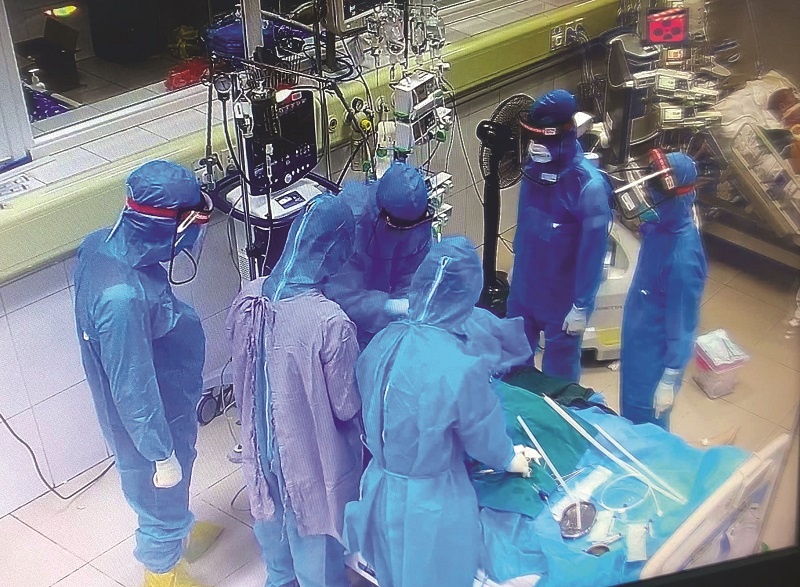Vietnam encourages private investment in sustainable healthcare development
 |
| Nguyen Thanh Long, Minister of Health |
What are the highlights of Vietnam’s healthcare reforms to promote sustainable development?
Perhaps the most showing evidence of how far Vietnamese healthcare has come is our performance of the United Nations Millennium Development Goals (MDGs). Set in 2000 for completion in 2015, five of the eight goals were related to the healthcare sector. MDGs 4, 5, and 6 focused on improving health while MDGs 1 and 7 had some indexes related to healthcare.
As of 2015, Vietnam has achieved 16 out of the 17 targets while the last one has been nearly completed.
In our pursuit of the MDGs and comprehensive healthcare reform to improve the lives of Vietnamese people, we had come a long way. Compared to 1990, Vietnam reduced child malnutrition and death under five by two-thirds, and the death rate among mothers had been reduced by three-fourths. Moreover, people’s access to clean water has been improved by 50 per cent, the HIV infection rate is now below 0.3 per cent of the population, and malaria has been under control since 2011.
Meanwhile, our capacity to forecast, supervise, and prevent diseases has been increased. Vietnam has successfully stopped pandemics such as Mers-CoV, Ebola, and Zica, and kept epidemics like influenza A (H5N1, H1N1), tuberculosis, malaria, and measles at bay. As a particular point of pride, Vietnam was also the first country to contain SARS.
Vaccinations have been strengthened and reinforced, and sustainably implemented in all communes and wards with the rate for children reaching over 90 per cent for 12 kinds of vaccines. As many as 23 of the world’s 35 kinds of vaccines are now in service in Vietnam. At the same time, the national target programme on prevention and fight against some dangerous and infectious diseases has proven dramatically effective.
The postpartum death rate among mothers dropped to less than a third of what it was in 1990, from 233 to 54 in 2015. The rate of mothers and newborn babies receiving first-week care postpartum in 2010-2015 hit 76-79 per cent.
For these achievements, Vietnam was highlighted by the World Health Organization (WHO) as a bright spot in the implementation of MDGs in the healthcare sector.
What stands in the way of the sector’s sustainable development going forward?
While the MDGs focused on care for mothers and children, and anti-infectious diseases where medical intervention is key, the UN Sustainable Development Goals (SDGs) extend the scope to financial risk protection, pollution and contamination, non-communicable diseases (NCDs), as well as mental health and well-being. The SDGs also look at risk factors like lifestyle, environment, and socioeconomic conditions. Therefore, the implementation of SDGs relies less on the health sector and instead requires collaboration among all agencies and society.
Although Vietnam has improved people’s health and lives in many areas measurable by indices, there remain many challenges. The poverty rate remains high, especially among ethnic minorities, while outdated customs and habits inhibit universal access to healthcare.
Moreover, the death rates among mothers and children in some mountainous areas are 3-4 times higher than in urban areas and nearly double the national average. The rate of child malnutrition remains high and average life expectancy remain relatively low in the northwestern and Central Highlands areas.
Vietnam has received a great deal of international support in the form of aid and preferential loans for the implementation of the MDGs. However, the country has reached the lower-middle-income status, with income levels that warrant far less international aid and preferential loans. However, state funding of healthcare remains limited, while people’s own spending on healthcare is still high at about 40 per cent.
The population is also large and continues to grow – while at the same time, the Vietnamese population is one of the 10 fastest-ageing countries on the globe. Gender imbalance at birth remains high while migration is still not properly controlled, putting great pressure on the health system. Vietnam is still burdened with infectious diseases and NCDs, accidents, injuries, pollution and contamination, epidemics, strange diseases, and especially the COVID-19 pandemic.
Vietnam is also one of the six countries most vulnerable to climate change and is one of the five countries most affected by natural disasters. Droughts, natural disasters, climate change, salinisation, and food contamination remain thorny issues.
Globalisation, global integration, and growing trade increase the risks of transmission of diseases, while state management agencies are struggling with the supervision of foreign-invested health facilities and their staff and limiting brain drain.
 |
| The level of treatment and care available at domestic hospitals has been continuously increasing |
What will the healthcare sector concentrate on to promote sustainable development in the future?
The sector will focus on a number of issues, such as reducing infection, death, and disability rates; controlling infectious diseases; and ensuring the efficient prevention and control of diseases, especially emerging ones to prevent mass transmission.
Moreover, we are planning investments in the development of the primary healthcare system. The grassroots healthcare system shall also be renovated while improving the development of human resources to ensure lifelong, universal healthcare for all.
The quality and efficiency of the service network should also be improved from the central to the grassroots level to adapt to changes like an ageing population, global integration, and digital transformation. Developments are also planned for the non-public health sector and public-private partnerships in healthcare.
Additionally, we want to maintain a stable replacement fertility rate and ensure a balanced sex ratio at birth, adapt to an ageing population, and increase population quality, among others.
An important goal is to develop human resources while intensifying scientific research and the application of high-tech prevention, diagnosis, and treatment.
We will aim to use domestically produced pharmaceuticals, herbs, and devices to ensure sufficient medicines, vaccines, and equipment at reasonable prices, meeting people’s demands for health prevention and treatment. We also need to control food safety by correctly assessing risks and regulating production and business.
Public spending on healthcare also needs to increase, in parallel to improvements to the efficiency of allocation and use of state budget and other resources for the sector. Priority needs to be given to state funding to develop preventive and grassroots healthcare in underprivileged areas.
Finally, we need to enhance the capacity of management and performance of healthcare policies and boost administrative reform while developing a health information system to meet the sector’s renovation and development demands.
How can private businesses contribute to the sector’s sustainable development?
In the past, private health facilities mainly provided diagnosis and treatment services for paying customers, but now many offer health insurance-based activities. The number of privately-run hospitals rose from 170 with 9,800 sickbeds in 2015 to 272 hospitals in 2020 with a total of 17,500 sickbeds. In addition, there are more than 37,600 private-run clinics that significantly contribute to meeting people’s healthcare demands.
In addition to fully foreign-invested hospitals, private ones are equipped with modern facilities and equipment and provide high-tech medical services. Some investors developed hospital chains like Hoan My and Vinmec.
Regarding privately-run pharmacies, more than 550 domestic pharmaceutical companies distribute medicines to 2,000 drug wholesalers, 43,000 retail pharmacies, and pharmacies in hospitals.
Along with medical services, private firms also provide services related to sanitation, waste treatment, and infrastructure, thus improving the quality of healthcare to meet people’s diverse demands.
The health insurance market is also developing strongly with annual growth rates of over 20 per cent in the past 10 years. The market now involves about 40 players and over 16.5 million policies.
Resolution No.20-NQ/TW from 2017 aimed to enhance citizens’ health protection and care. The state made budgetary allocations and adopted mechanisms and policies to mobilise and efficiently use resources to protect and care for and improve people’s health. The resolution set the goals of achieving 30 hospital beds per 10,000 people, and private hospital beds reaching 10 per cent of the total by 2025. By 2030, these rates will be 32 and 15 per cent, respectively.
Currently, private hospital beds make up over 20 per cent of the country total. New private hospital beds account for only 6 per cent, and mainly provide outpatient treatment services. Therefore, the role of private businesses is very important in the sector’s sustainable development in the upcoming time.
What the stars mean:
★ Poor ★ ★ Promising ★★★ Good ★★★★ Very good ★★★★★ Exceptional
Related Contents
Latest News
More News
- Vietnam's top 500 value-creating enterprises announced (December 27, 2025 | 08:00)
- The PAN Group shaping a better future with ESG strategy (December 26, 2025 | 09:00)
- Masan Consumer officially lists on HSX, marking the next phase of value creation (December 25, 2025 | 13:20)
- MCH to become the largest consumer stock on VN-Index (December 24, 2025 | 11:05)
- Oil and gas firms post strong 2025 results (December 22, 2025 | 17:42)
- SABECO wins multiple international beer awards (December 22, 2025 | 17:41)
- UOB sees Vietnam growth easing in fourth quarter (December 22, 2025 | 17:39)
- First members of Danang International Finance Centre revealed (December 22, 2025 | 17:39)
- Human-centred governance seen as key to AI development (December 19, 2025 | 18:19)
- Top 10 notable events of Vietnam’s industry and trade sector in 2025 (December 19, 2025 | 14:00)

 Tag:
Tag:






















 Mobile Version
Mobile Version